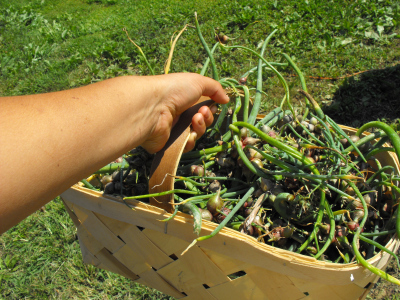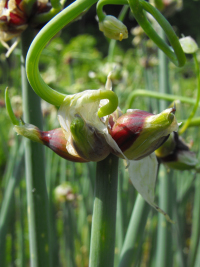
Egyptian onions for sale
 I
seem to have slightly over-planted our Egyptian onions this
year. I only put in three small beds...and then three more
patches sprang up from compost piles where I'd tossed the excess
bulbs. The result was so many
onions that I didn't even put a dent in the population by pulling whole
plants to eat over the winter, and now that it's time to harvest the
top bulbs,
I'm officially overwhelmed. This basket is less than a third of
the harvest!
I
seem to have slightly over-planted our Egyptian onions this
year. I only put in three small beds...and then three more
patches sprang up from compost piles where I'd tossed the excess
bulbs. The result was so many
onions that I didn't even put a dent in the population by pulling whole
plants to eat over the winter, and now that it's time to harvest the
top bulbs,
I'm officially overwhelmed. This basket is less than a third of
the harvest!
Rather than composting
the top bulbs (a method that clearly failed last year),
I'm going to sell them in big bunches to anyone willing to start a
good-sized Egytian onion patch. I don't really want to get into
the retail side of mailing off a few bulbs here and there, but if
you're a regular commenter and just want a tiny start, email
me and
I'll likely oblige you. You definitely want these plants in your
garden if you grow in
zones 3 through 9. Sorry, I can't mail them outside the U.S.
To order, click on the
paypal button above to buy 100 top
bulbs for $25 (with free shipping.) 100 bulbs will weigh
approximately 5 ounces and will be enough to start one good-sized bed
that will feed one or two average people. Your package will
contain small, medium, and large bulbs.
If you really want to
feed an army (and help me get rid of these top
bulbs as quickly as possible), you can buy 500 top bulbs for $75 (with
free shipping.) If so, click this button instead.
 Once
you receive your bulbs, plant the Egyptian onions as soon as
possible in good garden soil in full sun. The very top of the
bulb should be poking out of the ground, but the rest should be
submerged. Some people recommend planting them a foot apart, but
I've found that my plants do well in raised beds spaced only about
three inches between centers. Leave the plants alone for a few
months, then you should be able to start
harvesting green onions in the middle of the fall through the winter.
Once
you receive your bulbs, plant the Egyptian onions as soon as
possible in good garden soil in full sun. The very top of the
bulb should be poking out of the ground, but the rest should be
submerged. Some people recommend planting them a foot apart, but
I've found that my plants do well in raised beds spaced only about
three inches between centers. Leave the plants alone for a few
months, then you should be able to start
harvesting green onions in the middle of the fall through the winter.
To maintain a perennial
patch, cut only every second or third leaf,
making sure that the plant has enough green leaves to continue
growing. You can also dig up entire bulbs in the winter to use in
recipes that call for leeks, but you'll want to let all your plants
grow
the first year. By this time next year, your plants should be
putting up top bulbs, each of which can be planted to expand your
patch. As long as you don't get too greedy and overharvest,
Egyptian onions will soon become your most dependable --- and easiest
--- vegetable.
Want more in-depth information? Browse through our books.
Or explore more posts by date or by subject.
About us: Anna Hess and Mark Hamilton spent over a decade living self-sufficiently in the mountains of Virginia before moving north to start over from scratch in the foothills of Ohio. They've experimented with permaculture, no-till gardening, trailersteading, home-based microbusinesses and much more, writing about their adventures in both blogs and books.
Want to be notified when new comments are posted on this page? Click on the RSS button after you add a comment to subscribe to the comment feed, or simply check the box beside "email replies to me" while writing your comment.
- Remove comment
- Remove comment
- Remove comment
- Remove comment
